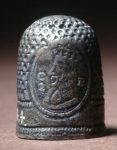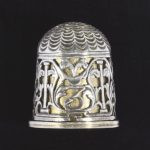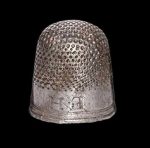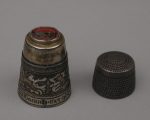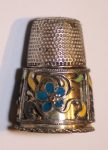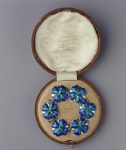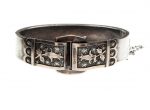Silver Thimbles. Thimbles are usually made from metal, leather, rubber, and wood, and even glass or china. Early thimbles were sometimes made from whale bone, horn, or ivory. Natural sources were also utilized such as Connemara marble, bog oak, or mother of pearl. Rarer works from thimble makers utilized diamonds, sapphires, or rubies.
Advanced thimble makers enhanced thimbles with semi-precious stones to adorn the apex or along the outer rim. Cabochon adornments are sometimes made of cinnabar, agate, moonstone, or amber. Thimble artists would also utilize enameling, or the Guilloché techniques advanced by Peter Carl Fabergé.
In the 19th century, many thimbles were made from silver; however, it was found that silver is too soft a metal and can be easily punctured by most needles.
Charles Horner solved the problem by creating thimbles consisting of a steel core covered inside and out by silver, so that they retained their aesthetics but were now more practical and durable. He called his thimble the Dorcas, and these are now popular with collectors. There is a small display of his work in Bankfield Museum, Halifax, England. Reference: Wikipedia
Below are some examples of silver thimbles which have been used throughout history.
Thimble; silver; horizontal rows of dots, ornamented with two ovals, one containing crowned head and legend, other with worn female head. Date 17th Century
Reference: © The Trustees of the British Museum
A German silver and silver-gilt thimble UNMARKED, GERMAN, PROBABLY NUREMBURG, LATE SIXTEENTH EARLY/SEVENTEENTH CENTURY In two parts, the outer part with scalework indentations above a wide pierced border decorated with lovebirds, a heart and flower amidst scrolls, a bayonet fitting releasing a silver-gilt inner sleeve, the tip engraved with two arrow pierced flaming hearts and an inscription in German, loosely translated, “The details ever surprise”, the side engraved with an insciption, loosely translated, “Loving and not being together, Heavens, it’s painful for my soul” — 7.8 in. (2.2 cm.) high
Sold for GBP 4,750 at Christies in 2007
18th century AD. A bell-shaped silver thimble with domed upper face, gusseted collar, upper body with lines of impressed dimples, above the collar are initials ‘EH’, inverted in relation to the dome.
Sold for £140 at TimeLine Auctions Ltd. in 2018
Thimble Date:1577 Culture:German, probably Nuremberg Medium:Silver partly gilt, enamel
Reference: The Metropolitan Museum of Art
Silver thimble with silver-gilt lining which is mounted with enamelled filigree. On top of the lining, which can be seen when the silver cap is removed, is a circle of reverse-painted glass, decorated with a pattern probably heraldic, consisting of three white circles on a red shield. 1570-1600 (made)
Reference: © Victoria and Albert Museum
